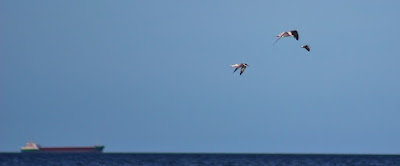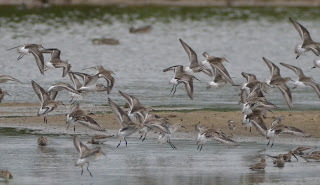The last week of July was spent on the beach at Southwold. A dawn visit to Minsmere was gorgeous with lots of waders including a strong posse of Spotted Redshank right in front of the hide with a supporting cast of Godwits. A flock of 30 Little Gulls moved through quickly but hung around just long enough to enjoy the range of plumages of this dainty Larid.
Icing on the cake of a brilliant morning at The Scrape was drinking in the adult Baird's Sandpiper that had been found the previous day, it was not showing for the first hour or so of daylight but then did just pop up in the Dunlin flock, a nice little adrenalin shot as I'd assumed it had probably moved on.
Butterflies were varied and at certain points abundant. There were still some slightly jaded Silver-studded Blues on the heathland along with some iridescent Common Blue. A treat indeed was in store from the Canopy Hide, where it was possible to watch Purple Hairstreaks going about their business without neck contortion. Their tussles with Grayling were a surprise, as they too were dashing around at canopy height.
The summer is wedding season and my cousin's called for an overnight stay in Derby. This brightened up a little when, on parking in the multi-storey, the concrete cavern was resonating to a cacophony of Peregrine noise. On inspection the rear of the car park overlooked Derby Cathedral where Peregrines have reared young for many years now. When I opened the hotel curtains on the 6th floor the following morning the tiercel, shot past in clear pursuit. Two minutes later he cruised by the window again. This was eyeball to eyeball stuff as he cast me a look, passing within 10ft, a pigeon limp within his talons.
Back on the Fens it was muggy and sleepy. At Roswell Pits Willow Emeralds seemed very well established, the first county record of this colonising damselfly was at this site just 2 years ago. Another localised rarity is the White-spotted Pinion, a moth that has pitched up in the garden moth trap three years on the trot now.
A rewarding trip to Welney yielded a family party of Cranes, a juvenile Temminck's Stint and a troupe of dozing Garganey amongst the moulting dabblers.
If there needed to be any further reminder of the slipping of summer into the comforting tangle of the autumn, a Spotted Flycatcher took up a temporary residence at the front of the house on it's way south.
Although it won't be the last trip to the beach the first days of September certainly saw the last with any real warmth. Just offshore another Hilary Burn plate from childhood formed as a dipping and diving procession of Terns - Arctic, Common, Sandwich and Black gathered in the sun.

Let's see what the East wind brings..........................





















































